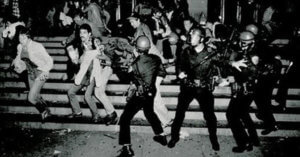
It isn’t hard to find memes and T-shirt’s, that announce Pride month by claiming that “the first Pride march was a riot.” This is true in some regards and misleading in others.
We celebrate Pride in June to commemorate the Stonewall riots in New York City. A police raid on the Stonewall Inn in the early morning hours of June 28th, 1969 set off riots over multiple nights and is considered today to be the a major event that began the modern gay rights movement in the United States. While there were gay and lesbian activist activities that pre-date the Stonewall uprising, Stonewall is considered the start of the modern LGBTQ Rights movement because of the effects it had, in the weeks, and months that followed.
No one in 1969 could have anticipated the revolutionary effect it would have, when a group of marginalized folks including drag queens, transgender persons, effeminate young men, butch lesbians, male prostitutes, and homeless youth decided to fight back against the all too common, police raid.
Stop and really, thoroughly, consider for a moment, that list of people listed involved in pushing back:
drag queens, transgender persons, effeminate young men, butch lesbians, male prostitutes, and homeless youth.
No one in 1969 , did it out of “pride” in the way we probably think of Pride today. But today, we recognize the immense significance, because in that effort, a group of marginalized persons said, enough is enough, and stood up against extortion, bribery, blackmail, violence and discrimination, which were the status quo for the queer persons at the time.
Today in 2019, there are calls to return to the beginning and “remember the first Pride was a riot.” Which is a highly poetic idea. It colors history with a rose tinted glass even while it intends to highlight the extreme sense of resistance displayed that night in 1969, and the nights that followed. But few really talk about what it was about that night that should be so important to us today, and tomorrow and the next day. Indeed probably the first Pride can be better traced to the first years that the Stonewall riots were commemorated, rather than the stonewall event itself. But I think there is real value focusing on the riots and what came after.

Those marginalized people- drag queens, trans, queer, effeminate, dykes, hustlers- put everything on the line. Those people, seen as the real dregs of the queer subculture, were the ones who risked everything, and their efforts resonated with a broader community, sparking nights of uprisings and skirmishes with the police. And then, in the weeks after, the community began to organize with a goal of creating safe places for LGBTQ persons to congregate and be themselves.
Let me say that again.
In the weeks following, the community began to organize.
There were gay and lesbian activists before Stonewall and their efforts are part of the history that got us to where we are today, but it is easy to argue that their efforts excluded many, that today we own proudly as part of the LGBTQIA+ community. I’ll leave discussing that, for a different post.
In 2019, we can claim that the first Pride was a riot, and we can bemoan what we see today as a homogenized, corporatized, and white-washed Pride. But if we really want to take a note from 1969, we will see Pride as motivation to stop living our status quo lives and organize. It isn’t Pride itself, which is most important. Rather it is what comes from Pride. What happens after, and how the community gets changed by Pride.
So, Pittsburgh, are you ready to notice that the first Pride was a riot? Will it prompt you to take to the street for nights following and risk everything? And in the weeks after, will you be out organizing and changing, and working for real change. Or will you return to what you always do, and the ways you always act, and your life as it was before?
There are a number of good resources for learning about Stonewall and the queerstory of the LGBTQIA community, but an easy place to start is the Wikipedia entry. It is long but still easy to read all of it in a short sitting. Here is info on the History Collection, the site where the 1969 photo is from